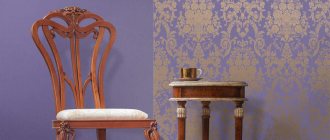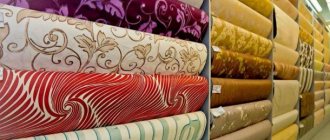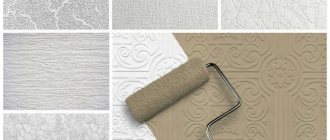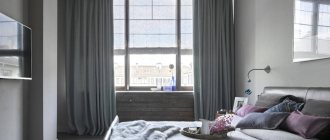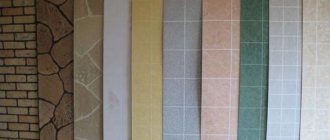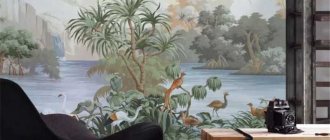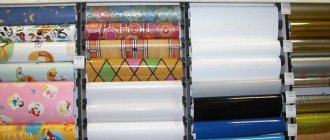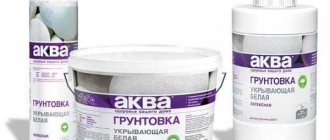What wallpaper is and what it is intended for is well known to everyone. This finishing material is hundreds of years old. They were first created in China, 200 years BC. e. Much has changed since then. And even though this is one of the cheapest finishing materials, it is practical and reliable. True, not all types of wallpaper are cheap and short-lived.
We can say with confidence that the time of ordinary wallpaper is over. Modern realities are such that manufacturers present a wide range of high-quality products with excellent performance characteristics: for example, non-woven wallpaper.
How do they differ from others, what types are available and what are their advantages. This is what we will look at later in the article.
Description and features of non-woven wallpaper
To make wallpaper based on non-woven fabric, a special fabric is used. It feels like plain paper, but is much stronger and protected from premature wear. Quite often, non-woven fabric is used in the manufacture of outerwear. It serves as a seal or lining. Unlike paper, non-woven fabric is difficult to tear, stretch or get wet. This is why it is good for creating wall finishing materials.
Non-woven wallpaper with backing has a simple composition. They are 70% made from cellulose. The remaining 30% is made up of polymer binders. Thanks to them, the material remains solid, durable and reliable. All components are connected to each other using the pressing method. This treatment forms a non-woven fabric with the following characteristics:
- high elasticity;
- strength;
- breathability;
- wear resistance;
- fire protection;
- protection from moisture;
- environmental cleanliness.
Since non-woven fabrics are soft, they are easy to work with. This is important for novice craftsmen who have not yet had experience with wallpapering. On the other hand, the weight of the products is large, so for the job you need to choose high-quality and thick glue that can hold strips of wallpaper on the wall.
There is no doubt about the quality of the products. They will last for decades without losing their original appearance. Depending on the type of wallpaper, they can even be painted.
I would like to pay special attention to the labeling. There are 18 points that indicate the features of wall products. For example, one wave indicates that the wallpaper is waterproof. Two - that they are washable, three waves, that the wallpaper is super washable. Wave, stripe and dotted lines indicate wear resistance. Images of half the sun are relatively light-resistant wallpapers. The image of the sun is very light fast. It is important to take into account that it is better not to wash embossed wallpaper on a non-woven basis, but to clean it with a vacuum cleaner.
Wallpaper type and size
Coatings from different components are produced in different sizes. When you know the size, sometimes it is possible to determine the type of canvas or vice versa.
Generally accepted production rules are:
- Paper webs are small in size. The width is often standard and is 53 cm.
- Foamed vinyl sheets can be either meter or half meter. Meter versions are produced exclusively with a non-woven backing.
- Hot stamped vinyl products are often made in large widths.
- Most silk fabrics have small widths.
- Materials for further coloring are long and can be produced in different widths.
- If the dimensions do not fit any standard, then vinyl wallpaper made in Europe is used. The cost of such products is quite high and they are often used to implement unusual design solutions.
- The sizes of photo wallpapers may vary; they are indicated on the product packaging.
As you can see from the article, the sizes of wallpaper coverings can vary quite a lot. There are standard solutions with a given width and height, but there are also a large number of other options. So-called meter-long canvases have a number of advantages over half-meter ones; they will significantly simplify the gluing procedure. Using the images used in the article, you can see all the coating options.
Dimensions
Products are sold in rolls. Their sizes are standard and are available in two versions. Width 53 cm and 1.06 m. Each type has its own advantages and disadvantages. For example, meter strips are much faster to glue onto the surface of walls (twice as fast). In addition, there will be fewer joints of sheets with each other on the wall. They are also easy to store. However, if they are single-layer and thin, then in the process there is a high chance of tearing the fabric.
If we talk about the length of the products in one roll, then it is exactly 10.06 m. There is one exception - this is smooth non-woven wallpaper for painting. One roll contains 25 m of material.
Roll length and area
The situation with the length of the coating is much simpler than with the width. There are several basic additional solutions and one that is the most common.
The standard length for wallpaper is 10.05 m - most canvases are produced in this size. An additional solution is a length of 15 m - used in the production of vinyl coverings with a standard width and pattern for further painting. Another option is a length of 25 m - used for the production of meter-long non-woven coatings for painting.
There is nothing wrong with a wide variety of covering heights. You just need to decide how many whole canvases you can create from them. But for owners of buildings with a ceiling height of up to 2.6 m, the use of such finishing can become quite problematic. There may be quite a large amount of waste left, or you will need to do the gluing yourself, leaving a large allowance at the bottom. In this case, the horizon of the floor may disappear, as a result of which it will not be possible to cover it with a plinth. You can get rid of these difficulties by using canvases of standard height or by correctly measuring the height of the coating.
You can calculate the required amount of material yourself or use the services of a consultant. You will definitely need to clarify whether it will be possible to purchase additional wallpaper in case there are still not enough of them.
When calculating how much wallpaper is contained in a roll, you need to rely on GOST data. Length has a strong effect on roll area. The following options exist:
- With generally accepted roll parameters, the area is approximately 5.3 m².
- With a length of 15 m and a standard width, the area is 7.95 m².
- With a length of 25 m and a width of 1.06 m, the area will be 25 m².
When calculating the required amount of wallpaper, you need to pay attention to the height of the ceiling. This indicator is of key importance. If the height is higher than 2.5 m, then you will need to use more wallpaper, but there will also be an increase in unused leftovers. For more detailed calculations, you can use the following table.
Types of non-woven fabrics
Thanks to a wide range of products, everyone can choose products to suit their taste, based on the interior of their house or apartment. Let's look at all of them in more detail.
Smooth
Ideal option for painting. These are purely non-woven products consisting of one layer of material. Different types of cellulose fibers are used for production. There are modified and unmodified smooth non-woven wallpapers, glued and unglued. The thickness and density of the canvas depends on the manufacturing method. After gluing them, you need to paint the non-woven wallpaper in the selected color.
Foam trellises on non-woven fabric
They consist of two layers. Obtained by exposure to high temperature. During the process, the vinyl heats up and a porous structure forms. The resulting products are foamed. This allows you to form various patterns and designs on canvases. Wallpaper with hot stamping on a non-woven base feels very soft to the touch.
Embossed
They are made only from several layers. This creates a structural pattern or pattern on the surface. The advantage of such coatings is that they can imitate some popular building materials and have different patterns. Materials: decorative plaster, wood, leather, fabric. From drawings: monogram ornaments, abstraction, flowers with sparkles and others.
For painting
An improved version of the nasty non-woven wallpaper. One of the most popular options all over the world. They are used for interior decoration of offices and private housing construction. The advantage of this option is that the fading old color can be renewed. Even if you’re just tired of it, changing the color is easy.
These are both smooth and textured wallpapers. No adjustment is required when cutting, which simplifies the work. And creative people can paint the surface not with one color, but with several, creating a unique and original design.
Important! There are both wall and ceiling non-woven wallpaper. They can also be painted and can remain on the surface for a long time without peeling off from the ceiling.
Types of wallpaper by composition and manufacturing method
Paintable canvases are as follows:
- paper;
- vinyl;
- non-woven;
- fiberglass (glass cloth).
Each type of wallpaper is characterized by its own characteristics, advantages and disadvantages.
Paper
This type of wallpaper consists of two or three layers of paper glued together. The coating can be smooth or embossed with varying degrees of pattern expression. The finishing material is made from natural ingredients, has high vapor permeability, and masks surface unevenness well. Another plus is the economical cost. Disadvantages of the material are the likelihood of shrinkage, deformation or damage during gluing. But if you choose a reliable manufacturer, for example, the German brand Erfurt, the wallpaper will be highly durable and also fireproof.
Paper wallpapers are divided into the following types:
- Raufazer - three-layer, with the addition of sawdust between the layers, creating a chaotic texture. They are distinguished by their low price and good ability to hide wall defects. They shrink, so the glue must be applied directly to the canvas, then give it the opportunity to absorb and allow the wallpaper to take its final shape;
- Fleece Raufazer - with a bottom layer of paper treated against shrinkage. The adhesive can be distributed directly over the wall and dry wallpaper can be joined to it;
- Embossed - two-layer, with a lower paper layer and an upper cellulose layer, have a three-dimensional pattern. They are used to save paint, as they are less absorbent;
- Relief (lincrusta) - with a base made of paper, and a top layer of wood flour, wax, chalk, linseed oil. They have a pronounced ornament. Over time, the material becomes harder and more durable, but requires great care when gluing to walls.
Paper wallpaper can be damaged by mechanical stress. The average number of re-stainings is 5 times.
Non-woven
Characterized by high performance properties. Non-woven fabric is a durable non-woven material made from layers of cellulose tightly pressed together. The coating can be smooth and textured, available in white or colored versions.
If you choose paintable wallpaper made entirely of non-woven material, it will be environmentally friendly and non-toxic. At a lower cost, you can purchase canvases where the top coating is replaced with a layer of vinyl. This impairs the breathability and safety of the wallpaper.
Smooth non-woven wallpapers have different densities, which affect the masking ability of the material. Textured options are usually produced with a low depth of ornament. It must be remembered that with each re-application of paint the pattern will become less visible.
The advantages of non-woven finishing also include:
- maintaining the original shape without shrinkage;
- high resistance to stretching, mechanical damage, moisture and fire;
- good breathability;
- Possibility of repainting up to 8 – 10 times.
The disadvantages include the high cost, large width and weight of the canvases, which complicates the gluing of walls.
Glass wallpaper
This type of wallpaper is produced by gluing glass fibers made from quartz sand or broken glass. Additionally, soda, lime, dolomite, and starch are used as adhesive impregnation. The composition of the coating is as environmentally friendly and hypoallergenic as possible. Wallpaper has a smooth structure or a relief pattern of varying degrees of complexity and volume.
Advantages of the material:
- not only hide uneven walls or ceilings, but also strengthen them;
- long useful life - up to 30 years for some manufacturers;
- possibility of repainting more than 10 – 15 times;
- non-flammability;
- increased strength and density;
- moisture and light resistance.
Fiberglass wallpaper is an expensive type of finishing that can be painted. The total cost of repairs is increased by the need to purchase special glue, which is high in consumption. The coating bonds very firmly to the surface it is applied to, making it difficult to remove. When working, it is mandatory to use personal protective equipment - a respirator, goggles, gloves.
Vinyl
Vinyl wallpaper is one of the most affordable options for painting. A paper or non-woven layer is used as a backing. The textured pattern on the canvases is created thanks to vinyl foam coating.
If the bottom layer is made of paper, the wallpaper may shrink. The non-woven base increases the strength of the canvas and simplifies repair work. The material requires careful handling during operation - there is a high risk of mechanical damage. Vinyl coating is characterized by low environmental friendliness - synthetic components are used in its production. This type of finish is characterized by insufficient vapor permeability, which can cause mold to form.
Smooth vinyl wallpaper with a non-woven backing is recommended for use on ceilings. Reduced risk of coating damage increases the number of possible re-paintings.
Pros and cons of non-woven products
No wonder the paintings have become so popular all over the world. They are valued for their advantages and special features. Non-woven wallpaper has its pros and cons. Let's start with the positive points:
- Ease of working with the material. Beginners are recommended to start with this type of wallpaper. There will be no problems with choosing glue either. The main thing is that it does not foam, does not spread and has a thick consistency. There should be no lumps in the composition either.
- Are non-woven wallpaper harmful or not? No, they are safe and can be used for interior decoration. After all, we know the composition of non-woven wallpaper; basically it is only environmentally friendly cellulose, which does not harm the body.
- Using wallpaper in decoration allows you to save useful space. If work is carried out in a small apartment, then the facing material will not take up useful space. The thickness of non-woven wallpaper is small, as is the required layer of adhesive.
- The products allow you to visually align walls. If you need to hide serious imperfections, they prefer to use canvases that have a relief top layer.
- Non-woven wallpaper a meter wide is applied very quickly. Work in one room can be completed in a few hours. It will take about a day to process the house. The joints on the surface will not be so visible.
- The material is resistant to getting wet from the adhesive mass. But so that the question does not arise: why non-woven wallpaper bubbles, you need to apply the glue correctly, without gaps and in an even layer.
- If the trellises need to be replaced, they are fairly easy to remove.
- The products breathe, are not afraid of fire, are wear-resistant and can withstand other negative influences. Thanks to this, they have a long service life.
- Due to its elasticity, the material can stretch slightly without deforming. This allows you to use non-woven wallpaper even in new buildings. Shrinkage and cracks are not a problem for the coating.
- Protection from moisture allows the material to withstand the influence of steam and water, not deform when exposed and return to its original position. Thanks to this, the products can be used in damp areas.
- If you have small children at home, then by choosing washable non-woven wallpaper, you won’t have to worry about them, since the wallpaper is easy to clean.
But, along with positive qualities, non-woven products also have their disadvantages:
- Inconveniences arise with embossed types of products, as they collect dust and are quite problematic to care for. You need to regularly allocate time and effort to clean dust from your products;
- children or pets may damage the design or integrity of the wallpaper;
- some types of (multilayer) products are quite expensive;
- non-woven fabric – transparent materials. This means that good preparation of the walls is required before gluing single-layer wallpaper. There should be no stains, and the surface should be the same color. This is not required if the top layer is made of fabric. Textile wallpaper hides wall imperfections well;
- if you overdo it with glue and apply more of it than necessary, this will lead to marks under the canvases.
It is important to remember that water-based paint is used to paint wallpaper. It is not included in the kit, so you will have to buy it yourself.
Why choose wallpaper for painting walls?
Unlike conventional painting, such wallpaper requires less effort and time for repair work. Before applying paint compositions directly to the walls, careful leveling, sanding, and priming are required. If this is not done, all irregularities and defects will be very noticeable. Wallpaper can be glued even to imperfectly smooth walls - their dense structure and the presence of reliefs will hide many imperfections.
Repainting requires preparatory work. It is important to remove all dirt and dust from the surfaces, smooth out uneven surfaces, apply putty, several layers of primer; dismantling of peeling parts of the wall is often necessary. If you buy wallpaper for painting, when repainting it, it is usually enough to remove dirt and dust using wet cleaning or a vacuum cleaner.
Another plus is the wide selection of reliefs. The desired pattern is already applied to the canvas; it is enough to simply cover it with paint. Making ornaments on painted walls requires a lot of effort and special knowledge - most often you will have to order the services of professional repair teams.
Non-woven wallpaper
These products are known for the fact that in them the interlining acts exclusively as the main one, on which another decorative layer is already applied as an addition. For this purpose the following are used:
- paper;
- textile;
- vinyl.
The price of the product directly depends on the type of additional layer, its quality and quantity. Let buyers not be surprised that similar products on the shelves can have a wide range of prices, despite outwardly similar characteristics. For example, non-woven paper wallpaper has the lowest cost.
Experts do not recommend using cheap options for your home that do not have a quality certificate. Otherwise, they will quickly lose their external characteristics and become unusable. It is better to pay more, but be sure that in a few years you will not have to buy new products. This will take not only additional funds, but also time and effort for repairs.
High quality vinyl coating allows the material to last even longer. During operation, the products will not fade under the influence of the sun and will not lose their appearance. And dust and dirt can be easily removed with a damp cloth.
The manufacturer's packaging contains instructions and recommendations for use. We recommend that you familiarize yourself with them so that there are no problems with future operation.
Features of combining two or more types of wallpaper
To create an interesting and original interior, they create combinations between several types of wallpaper. To make it high quality and beautiful, you need to understand how to combine products. Otherwise it will turn out ridiculous.
Among the suitable wallpaper combinations it is worth noting:
- Range. Emphasis on color. From dark to light. Dark burgundy fades into soft pink. The transition should be smooth;
- Duet. Emphasis on ornament. It is important to choose the right design so that it does not look tasteless. Geometry is combined with abstraction, vertical stripes with a cute pattern;
- Balance. Combination of plain products with models with ornaments and patterns;
- Contrast. Combination of bright color with neutral shade;
- Texture. Combination of embossings. It is recommended to choose plain wallpaper from the same material.
To create an interesting and original interior, they create combinations between several types of wallpaper.
Designations on non-woven products
To simplify the task of choosing the best option for yourself, non-woven smooth or corrugated wallpaper has designations. We talked about some of them above. But this is not all that can be learned from the labeling. Thanks to it, you can find out how to apply the glue correctly, whether it is possible to remove the wallpaper after pasting in order to correct it, shock resistance, etc. To simplify the task, we have prepared all these symbols in the figure below:
We looked at what regular non-woven wallpaper is, their features, varieties, advantages and disadvantages. We can confidently say that this is one of the best options in terms of price and quality ratio. They are very easy to work with, they are not afraid of moisture, fire, wear-resistant and environmentally friendly. Having chosen this facing option for yourself, no one will regret it. The main thing is not to skimp on your purchase and follow the instructions for gluing it to the wall.
How to properly glue meter-long non-woven wallpaper
The process of gluing coatings with a width of 1 m is faster than conventional ones, however, you need to take into account some features:
- The walls should be smooth and even; it is useful to treat them with a primer and a spatula to ensure a good leveling. This will improve the joints of the adhesive mixture with the wall.
- When cutting rolls incorrectly, it happens that the length of the last sheet is not enough. To correct the situation, you can first glue the plinth to the ceiling, this will save on allowances.
- If the ceilings are flat, it is advisable to leave an allowance of up to 3 cm when cutting the fabric. If the ceilings are crooked, then add 10 cm to the margin.
- If the corners in the room are not perfectly even, then you should not glue meter-wide coverings from the corner; it is better to step back a little from the edge. This will avoid distortion of the drawing.
- The edges of each subsequent sheet are placed as close as possible so that the joints are as less noticeable as possible and the parts of the pattern correspond to each other.
Important! Before starting work, carefully study all the recommendations and rules, prepare the necessary tools. This will speed up the process and help avoid mistakes.
Wallpaper Android 2.3 Gingerbread
In the Android 2.3 Gingerbread operating system, a lot of work was done on the interface and its overall appearance, so Google also selected beautiful backgrounds for the new icons and menus.
Nature and abstraction remain the main theme of the wallpaper in this version of Android. .
Wallpaper Android 6.0 Marshmallow
The Android 6.0 Marshmallow update was large in terms of new features and work done under the hood of the system, but its external style did not change. In terms of desktop backgrounds, Google has simply expanded on the "lollipop" motif by adding some new wallpapers featuring photos of the earth's landscape.
.
Wallpaper Android 7.0 Nougat
Android 7.0 Nougat, current at the time of this writing, brings a lot of new things to the Android ecosystem, but does not yet change its appearance, although the 7.1 update could change everything.
The style of the backgrounds hasn't changed much, but there is a warm pink color scheme (in the pictures). .
History of development and standard wallpapers from all versions of Android
Android is the most common mobile operating system. And despite the many manufacturers and add-ons, it is always based on some version of the system from Google. Let's take a look back over the last decade and remember how the system reached its current state.
Android 1.5 Cupcake
- Release date: April 27, 2009.
This version introduces the ability to install third-party keyboards and support for widgets on the home screen.
For the first time, users were able to use web page search. And the Bluetooth headset automatically connected to the device.
Android 1.6 Donut
- Release date: September 15, 2009.
An important innovation was support for WVGA resolution (480×800); in addition, Android began to support CDMA and VPN communication systems. Android Market received a visual update, and the search widget learned to search among contacts, bookmarks, history, and generate Internet search queries.
Android 2.1 Eclair
- Release date: October 23, 2009.
The desktop learned to display live wallpapers, and the system received support for working with multiple Google accounts, including an email application.
The developers have added the ability to search by SMS and automatically delete old messages when the set limit is reached. The browser has been redrawn. The system began working with several simultaneous touches (multi-touch).
Android 2.2 Froyo
- Release date: May 20, 2010.
The pixel density on the screen could reach 320 dpi (for example, 4 inches at 720p resolution). Smartphones have learned to act as an access point; a USB connection or WiFi could be used for this.
A general optimization of the operating system was carried out; the keyboard learned to quickly switch between several layouts. And now you could turn off cellular data and use the network only for calls.
Android 2.3 Gingerbread
- Release date: December 6, 2010.
This version was remembered for the launch of NFC support, the ability to type text in a few touches and use cut/paste. And those who downloaded large files to their smartphones began to master the download manager.
Android 3.0 Honeycomb
- Release date: February 22, 2011.
First of all, this version was intended for devices with large screen sizes, i.e. tablets.
The new design theme amazed minds with its modernity. The holographic interface was copied by third-party launchers for a long time.
Android 4.0 Ice Cream Sandwich
- Release date: October 19, 2011.
The version was designed to combine smartphones and tablets. The user's workspace has been redrawn again, making it more minimalistic. The polysemy system has undergone changes, support for WiFi-Direct and an Internet traffic control system have appeared. For the first time, a facial recognition system was implemented to unlock the device.
Android 4.1 Jelly Bean
- Release date: June 27, 2012.
The central and graphic processors began their parallel operation, which made it possible to achieve 60 frames per second, which the user observed when working with the system interface.
It was in this version of Android that the Google Now service first appeared. And with subsequent updates, it became possible to connect gamepads.
Android 4.4 KitKat
- Release date: October 31, 2013.
During the development of the update, the task was to optimize the work with the memory and computing resources of the smartphone. Speaking of the interface, the navigation buttons and notification panel began to hide when working with applications.
Through the built-in settings it became possible to switch between launchers. For the first time, the function of remote control of Android and launching applications in the “sandbox” was implemented.
Android 5.0 lollipop
- Release date: November 3, 2014.
This version of the operating system has been completely redrawn according to the new Material Design concept. Internal changes are based on the transition from the Dalvik virtual machine to ART, which has a positive effect on energy consumption.
This is perhaps one of the biggest updates. It concerned design, software optimization and security.
Android 6.0 Marshmallow
- Release date: May 28, 2015.
There were no major visible changes, but the system gained the ability to unlock with a fingerprint, and native support for two SIM cards was introduced.
Among the applications, users were able to find Android Pay, and real geeks began to master Project Brillo, a smart home control system.
Android 7.0 Nougat
- Release date: March 6, 2021.
This version allowed you to work with two applications on one screen at once. Notifications began to be grouped by application, and it became possible to respond to them directly from a push card. For comfortable work in the dark, night mode has been introduced.
Android 8.0 Oreo
- Release date: April 2, 2021.
Along with this version of the green robot, a completely redrawn notification demo based on Notification dots was supplied. Dynamic icons made it possible to display the number of new messages and get more detailed information with a touch.
It became possible to place the video material being viewed in a small window, thanks to the “picture in picture” function. The system has also learned to limit applications and background processes, which slightly extended battery life.
Based on this version, a lightweight build of Android Go appeared, which ensured stable operation of the system on low-power devices.
Android 9.0 Pie
- Release date: March 7, 2021.
The update is based on gestures as the main element of system control. The “home” and “multitasking” keys have disappeared from the interface. The dock became transparent and the clock moved to the left. The entire interface has lost its sharp corners.
Wallpaper Android 3.0 Honeycomb
Android 3.0 Honeycomb became almost the most disastrous version of the system. It was developed exclusively for tablets to compete with the then dominant iPad. Google has decided to split smartphones and tablets into two separate versions of Android, but the company will later abandon this decision. Despite all this, Android 3.0 Honeycomb brought a beautiful interface with the same stylish wallpaper in a blue color scheme.
.
Wallpaper Android 1.6/2.0/2.2 (Donut, Eclair, Froyo)
Three subsequent major updates under Android versions 1.6 Donut, 2.0 Eclair and 2.2 Froyo had a similar set of desktop backgrounds. With each update, this set was supplemented with several wallpapers. For example, after the release of Nexus One, the same background with the letter “X” appeared.
This time the theme of nature also prevailed, but some abstract gradients and wallpapers in the style of the Nexus brand were already added. .
